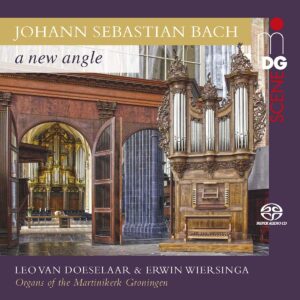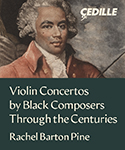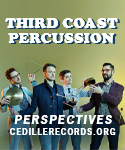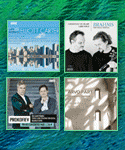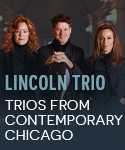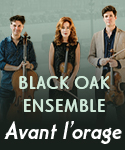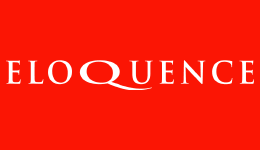There is no shortage of Bach organ recitals–and yet it never gets old. Orchestras may sound increasingly identical so that one band or another tackling yet another Beethoven symphony hardly makes a difference beyond the specific interpretation; but organs always retain their individual character so that two pieces played on two instruments, even if the respective organists are not out to prove some overtly individual point with their playing, would still sound considerably different. That–and more–is the case here, as Leo van Doeselaar and Erwin Wiersinga share a disc of transcriptions on the two instruments of the Martinikerk in Groningen.
The playing of the two Martinikerk’s titular organists is terrific. The balance of their steady pulse and the flair in the registrations, of control and grandness, impresses on first listening. The choice of works is fabulous, too, familiar-yet-unfamiliar as it is to hear some of these pieces on the organ. There are very straight 1:1 transcriptions like the Toccata in D, the Italian Concerto, and three excerpts from the Art of Fugue. Then there is an adaptation of Gustav Leonhardt’s harpsichord arrangement of the Ciaccona, Leo van Doeselaar’s own transcription of the Sinfonia from Cantata BWV 29, and Erwin Wiersinga performing Guy Bovet’s arrangement of the Concerto in A for four harpsichords, which is, of course, Bach’s transcription of a Vivaldi concerto. It all culminates in Sybolt de Jong’s transcription for four hands(!) and two feet of the chorus “Ein feste Burg ist unser Gott” from Cantata BWV 80.
The large Schnitger organ, which goes back to an instrument built by the Master Johan of Appingedam between 1450 and 1482 and that was restored to its 1740 Schnitger-condition some 40 years ago, is a famous and popular instrument that features on many recordings, including the Bach cycles of Hänssler’s Edition Bachakademie, Bernard Foccroulle’s, Ton Koopman’s, Gerhard Weinberger’s, and Marie-Claire Alain’s third set. Here it takes turns with the smaller 1744 single manual Le Picard organ, on which the Ciaccona and the Art of Fugue retain all their contrapuntal clarity, without ever sounding undernourished compared to the grandeur of the Schnitger instrument. The recorded sound is exemplary in stereo from the SACD layer.






















